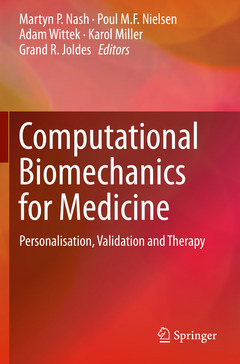Description
Computational Biomechanics for Medicine, 1st ed. 2020
Personalisation, Validation and Therapy
Coordinators: Nash Martyn P., Nielsen Poul M.F., Wittek Adam, Miller Karol, Joldes Grand R.
Language: English
Subjects for Computational Biomechanics for Medicine:
Publication date: 08-2020
Support: Print on demand
Publication date: 08-2019
149 p. · 15.5x23.5 cm · Hardback
Description
/li>Contents
/li>
This book contains contributions from computational biomechanics specialists who present and exchange opinions on the opportunities for applying their techniques to computer-integrated medicine, including computer-aided surgery and diagnostic systems. Computational Biomechanics for Medicine collects peer-reviewed chapters from the annual Computational Biomechanics for Medicine Workshop, in conjunction with the Medical Image Computing and Computer Assisted Intervention [MICCAI] Society conference. The works are dedicated to research in the field of methods and applications of computational biomechanics to medical image analysis, image-guided surgery, surgical simulation, surgical intervention planning, disease diagnosis and prognosis, analysis of injury mechanisms, implant and prosthesis design, artificial organ design, and medical robotics. These chapters will appeal to a wide range of researchers and students within the fields of engineering and medicine, as well as those working in computational science.




